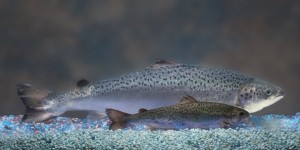
This undated 2010 handout photo provided by AquaBounty Technologies shows two same-age salmon, a genetically modified salmon, rear, and a non-genetically modified salmon, foreground.
By Madie Murray
To me, this is very scary. The Washington Post and other major news outlets broke a story this weekend saying the FDA released its findings that the fish do not pose a threat to the environment and “are as safe as food from conventional Atlantic salmon.” Read the entire article by clicking here.
On top of that, if we don’t start demanding the labeling of genetically altered foods, we won’t even know we’re eating genetically engineered (GE) salmon.
If this doesn’t bother you, then do nothing.
If this basically under-tested and dangerous technology in the hands of major corporations for profit does bother you, I urge you to take some kind of action against this trend of tampering with our food supply. There are ways…here is a good start:
- Fooddemocracynow.org – fighting against Monsanto et al
- Labelitwa.org – leading the fight in Washington to label GE foods
- ge-fish.org – Center for Food Safety site, chronicles the whole history of this fight
**If you are reading theOrcasonian for free, thank your fellow islanders. If you would like to support theOrcasonian CLICK HERE to set your modestly-priced, voluntary subscription. Otherwise, no worries; we’re happy to share with you.**








“basically under-tested and dangerous technology”
If it is under-tested, how do you know it is dangerous?
I am not saying that is safe or dangerous, and I certainly want to know if food that I purchase has been genetically modified. What I am trying to point out is that people need to be methodical and logical in addressing these issues. Sensational statements are more likely to be ignored by the people you wish to convince. After all, an unfounded statement that something is dangerous is as misleading as an unfounded statement that something is perfectly safe for you.
Point taken. I appreciate your reasoning and I agree with it. For the sake of not creating a lengthy article, I didn’t go into details about what made me state “under-tested” and “dangerous” but here is some information shaping my fears:
Dr. Michael Hansen, Senior Scientist of the Consumers Union that publishes Consumer Report calls the science used to justify the salmon’s safety as “sloppy,” “misleading,” and “woefully inadequate.” Reference: Food Safety News, The ‘Creepy’ Science Behind GM Salmon by Jill Richardson (https://www.foodsafetynews.com/2010/09/frankenfish-created-with-creepy-science/#.UNzslbYTURt)
The Center for Media and Democracy goes quite deeply into all the studies citing historical data, study flaws, study designs, interpretation, references and external resources in their “Concerns About Science Justifying the Safety of AquAdvantage Salmon.” (AquAdvantage salmon is what AquaBounty calls its GM salmon.) https://www.sourcewatch.org/index.php?title=Concerns_About_Science_Justifying_the_Safety_of_AquAdvantage_Salmon
And this doesn’t even address the possibility of GE fish being released into the natural salmon habitats either by acts of nature or of man. Researchers William Muir and Richard Howard at Purdue University warned as far back as 1999 that the accidental release of as few as 60 individual GM salmon into the wild could extinct wild salmon populations within 40 (salmon) generations.
Dr. Anne Kapuscinski, professor of sustainability science and chair of the Environmental Studies Program at Dartmouth College and a member of the Pew Environmental Group stated in an interview with National Public Radio on December 9, 2011 (https://www.pewenvironment.org/news-room/other-resources/anne-kauscinski-questions-safety-of-genetically-engineered-salmon-pew-marine-fellow-2001-85899368599) “I was concerned that there were some problems with small sample sizes, some problems with statistical analysis, and I was even more concerned that there were key parts missing from the risk assessment. It seemed like the approach taken, the risk assessment, wasn’t really up to speed with the state of the art risk assessment.”
There’s so much more and I urge anyone who wishes to know more to simply search the Internet for studies on genetically engineered or genetically modified salmon.
One aspect of this GMO salmon that I haven’t seen discussed is what I see as an end run around current regulations on farmed salmon. Pen net operations are limited to the densities of fish raised in pens in open water. Fecal matter tends to build up under open pens and become a source of pathogens. The practice of over populating pens in Norway lead to the destruction of entire river systems. This is what motivated the pen net operators to migrate away from Norway in the first place.
Enter the GMO salmon, a fish that grows twice as fast will produce twice as much fecal matter. Yet, so far as I know, the rules that limit numbers of fish as a measure of density in pen nets have not been part of the discussion regarding the new GMO salmon. If these fish are allowed to be raised in open pen nets under the present rules, it is a safe bet that we will see increased problems with wild stocks suffering from deadly diseases like spinner’s disease, which once established in a wild stocks can only be eradicated by poisoning the water shed and every living thing in it.
The idea that the GMO fish will only be raised in closed system farms is far fetched given the costs of such a system when compared with open pen net farms.